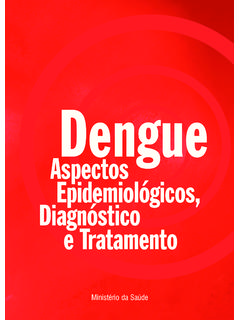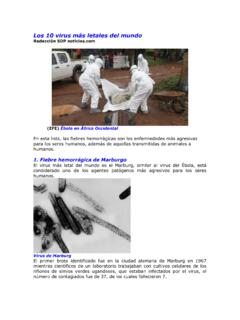Transcription of U.S. DEPARTMENT OF HEALTH AND HUMAN SERVICES …
1 dengue and dengue Hemorrhagic Fever | 1 dengue and dengue Hemorrhagic Fever Information for HEALTH Care PractitionersDengue is a mosquito -borne disease caused by any one of four closely related dengue viruses (DENV-1, -2, -3, and -4). Infection with one serotype of DENV provides immunity to that serotype for life, but provides no long-term immunity to other serotypes. Thus, a person can be infected as many as four times, once with each serotype. dengue viruses are transmitted from person to person by aedes mosquitoes (most often aedes aegypti ) in the domestic environment. Epidemics have occurred periodically in the Western Hemisphere for more than 200 years. In the past 30 years, dengue transmission and the frequency of dengue epidemics have increased greatly in most tropical countries in the American region. dengue Hemorrhagic Fever and dengue Shock Syndrome Some patients with dengue fever go on to develop dengue hemorrhagic fever (DHF), a severe and sometimes fatal form of the disease.
2 Around the time the fever begins to subside (usually 3 7 days after symptom onset), the patient may develop warning signs of severe disease. Warning signs include severe abdominal pain, persistent vomiting, marked change in temperature (from fever to hypothermia), hemorrhagic manifestations, or change in mental status (irritability, confusion, or obtundation). The patient also may have early signs of shock, including restlessness, cold clammy skin, rapid weak pulse, and narrowing of the pulse pressure (systolic blood pressure diastolic blood pressure). Patients with dengue fever should be told to return to the hospital if they develop any of these signs. DHF is currently defined by the following four World HEALTH Organization (WHO) criteria: Fever or recent history of fever lasting 2 7 days. Any hemorrhagic manifestation. Thrombocytopenia (platelet count of <100,000/mm3). Evidence of increased vascular permeability.
3 DEPARTMENT OF HEALTH AND HUMAN SERVICESC enters for Disease Control and Prevention Clinical DiagnosisDengue Classic dengue fever, or break bone fever, is characterized by acute onset of high fever 3 14 days after the bite of an infected mosquito . Symptoms include frontal headache, retro-orbital pain, myalgias, arthralgias, hemorrhagic manifestations, rash, and low white blood cell count. The patient also may complain of anorexia and nausea. Acute symptoms, when present, usually last about 1 week, but weakness, malaise, and anorexia may persist for several weeks. A high proportion of dengue infections produce no symptoms or minimal symptoms, especially in children and those with no previous history of having a dengue infection. The main medical complications of classic denguefever are febrile seizures and dehydration. Treatment of dengue fever emphasizes Relieving symptoms of pain. Controlling fever. Telling patients to avoid aspirin and other nonsteroidal, anti-inflammatory medications because they may increase the risk for hemorrhage.
4 Reminding patients to drink more fluids, especially when they have a high | dengue and dengue Hemorrhagic FeverThe most common hemorrhagic manifestations are mild and include a positive tourniquet test, skin hemorrhages (petechiae, hematomas), epistaxis (nose bleed), gingival bleeding (gum bleed), and microscopic hematuria. More serious types of hemorrhage include vaginal bleeding, hematemesis, melena, and intracranial bleeding. Evidence of plasma leakage due to increased vascular permeability consists of at least one of the following: An elevated hematocrit 20% above the population mean hematocrit for age and sex. A decline in hematocrit after volume-replacement treatment of 20% of the baseline hematocrit. Presence of pleural effusion or ascites detected by radiography or other imaging method. Hypoproteinemia or hypoalbuminemia as determined by laboratory is currently reevaluating the clinical case definition for dengue fever and DHF.
5 Studies from different countries have reported life-threatening complications from dengue in the absence of one or more of the current criteria for DHF. Despite the name, the critical feature that distinguishes DHF from dengue fever is not hemorrhaging, but rather plasma leakage resulting from increased vascular permeability. dengue shock syndrome (DSS) is defined as any case that meets the four criteria for DHF and has evidence of circulatory failure manifested by What to Look for When You Evaluate Patients for DHFEVALUATE the patient s heart rate, capillary refill, skin color and temperature, peripheral pulse volume, pulse pressure, and blood pressure. A drop in systolic blood pressure is usually the last sign and appears only when the patient is in FOR evidence of bleeding on the skin and at other FOR evidence of increased capillary permeability ( , pleural effusions, ascites, hemoconcentration).MEASURE and ask about urine female aedes aegypti mosquito obtaining a blood-meal from a HUMAN host through her proboscis, which penetrates the host s skin.
6 (1) rapid, weak pulse and narrow pulse pressure ( 20 mmHg [ kPa]) or (2) hypotension for age, restlessness, and cold, clammy skin. Patients with dengue can rapidly progress into DSS, which, if not treated correctly, can lead to severe complications and death. Fatality rates among patients with DSS can be 10% or higher but, with early recognition and treatment, can be less than 1%. DHF and DSS can occur in both children and and dengue Hemorrhagic Fever | 3 How to Treat dengue Fever Tell patients to drink plenty of fluids and get plenty of rest. Tell patients to take antipyretics to control their temperature. Children with dengue are at risk for febrile seizures during the febrile phase of illness. Warn patients to avoid aspirin and other nonsteroidal, anti-inflammatory medications because they increase the risk of hemorrhage. Monitor your patients hydration status during the febrile phase of illness.
7 Educate patients and parents about the signs of dehydration and have them monitor their urine output. If patients cannot tolerate fluids orally, they may need IV fluids. Assess hemodynamic status frequently by checking the patient s heart rate, capillary refill, pulse pressure, blood pressure, and urine output. Perform hemodynamic assessments, baseline hematocrit testing, and platelet counts. Continue to monitor your patients closely during defervescence. The critical phase of dengue begins with defervescence and lasts 24 48 hours. Clinical ManagementEven for outpatients, stress the need to maintain adequate hydration. Monitoring for warning signs of severe dengue and initiating early appropriate treatment are key to preventing complications such as prolonged shock and metabolic acidosis. Successful management of DHF and DSS includes judicious and timely IV fluid replacement therapy with isotonic solutions and frequent reassessment of the patient s hemodynamic status and vital signs during the critical phase.
8 HEALTH care providers should learn to recognize this disease at an early stage. To manage pain and fever, patients should be given acetaminophen. Aspirin and nonsteroidal, anti-inflammatory medications may aggravate the bleeding tendency associated with some dengue infections and, in children, can be associated with the development of Reyes syndrome. Laboratory DiagnosisUnequivocal diagnosis of dengue infection requires laboratory confirmation, either by isolating the virus or detecting dengue -specific antibodies. For virus isolation or detection of DENV RNA in serum specimens by serotype-specific, real-time reverse transcriptase polymerase chain reaction (RT-PCR), an acute-phase serum specimen should be collected within 5 days of symptom onset. If the virus cannot be isolated or detected from this sample, a convalescent-phase serum specimen is needed at least 6 days after the onset of symptoms to make a serologic diagnosis by testing for IgM antibodies to dengue with an IgM antibody-capture enzyme-linked immunosorbent assay (MAC-ELISA).
9 Acute-phase and convalescent-phase serum samples should be sent to the state HEALTH DEPARTMENT or to the Centers for Disease Control and Prevention (CDC) for testing. Acute-phase samples for virus diagnosis may be stored on dry ice (-70 C) or, if delivery can be made within 1 week, stored unfrozen in a refrigerator (4 C). Convalescent-phase samples should be sent in a rigid container without ice, if next-day delivery is assured. Otherwise, they should be shipped on ice in an insulated container to avoid heat exposure during transit. Most tests for anti- dengue antibodies yield nonspecific results for flaviviruses, including West Nile and St. Louis encephalitis viruses. Because commercial kits may vary in sensitivity and specificity, test results may need to be confirmed by a reference | dengue and dengue Hemorrhagic Feverthe Dominican Republic, El Salvador, Guatemala, Honduras, Mexico, Nicaragua, Panama, and Paraguay.
10 Although its contact with humans and its density in urban areas are not as great as that of aedes aegypti , this species also can transmit dengue viruses. As noted previously, the frequency of epidemic disease has increased significantly in the past 30 years. Modern transportation makes it easy for travelers to visit virtually any location on the globe, including areas of the world where dengue is endemic. Although travel-associated dengue and limited outbreaks do occur in the continental United States, most dengue cases in citizens occur as a result of endemic transmission in some of the territories. CDC conducts laboratory-based, passive dengue surveillance in Puerto Rico in collaboration with the Puerto Rico DEPARTMENT of HEALTH (PRDH). The PRDH Web site provides a weekly dengue surveillance report produced by CDC and PRDH at a dengue -like illness is observed in a person in the continental United States who has recently traveled to a tropical area, acute and convalescent blood specimens, associated clinical information, and a brief travel history should be sent to the state public HEALTH laboratory with a request that the specimens be tested for dengue there or sent to CDC s dengue Branch in San Juan, Puerto Rico.












